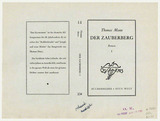Sweden
Refugee policy in a Sweden governed by social democrats was rigidly enforced until well into World War II. As in Switzerland, refugees were often only permitted to stay for a limited period.
Switzerland
Its immediate proximity to Germany, its long tradition of neutrality and its common language made Switzerland the most popular destination of those going into exile after the Nazis had seized power. As a result of several ordinances issued in March/April 1933, the numerous refugees seeking to enter Switzerland were subject to far-reaching restrictions.
The 1933 book burnings
Book burnings took place in many German towns and cities on 10 May, 1933 – only three months after the Nazis came to power. Lists compiled by librarian Wolfgang Herrmann, originally planned for a reorganisation of Berlin’s national and local libraries, were used to prepare such actions.
The aid organisation HICEM
HICEM was formed in 1927 by amalgamating the Hebrew Sheltering and Immigrant Aid Society (HIAS) in New York, the Jewish Colonization Association (JCA) in Paris and the United Jewish Emigration Committee (EMIGDIRECT) in Berlin. Its international branches provided information about living and working conditions in the destination countries, assisted refugees when communicating with the authorities, and helped finance their emigration.
The annexation of Austria in 1938
After Adolf Hitler forced the Austrian Federal Chancellor Kurt Schuschnigg to step down on 11 March 1938 and German troops marched into the country the following day, Austria ceased to be an independent state, instead becoming part of the German Reich. These events were the culmination of a longer-term development that had begun in 1934 with the establishment of a fascist “corporate state” (“Ständestaat”) in Austria.
The Bermann-Fischer Verlag
When the Nazis took power, Gottfried Bermann Fischer, son-in-law of the founder of the publishing, ran the Berlin-based S. Fischer Verlag.
The black series (film noir)
While the careers of German and Austrian actors were severely limited due to their language and lacking popularity, and many European-trained screenwriters had their difficulties with American tastes, an impressive array of émigrés in the field of directing made their mark in Hollywood films of the 1940s. The “film noir” movement was shaped in large part by German-speaking directors.
The Cummington Story
Emigrants in film Cummington is a small town in western Massachussetts. From 1940 to 1944, the town was home to a hostel for European refugees, including German artists.
The Emergency Rescue Committee
Rescued from “Surrender on Demand” in FranceThe Emergency Rescue Committee (ERC) was established in late June 1940 in New York by German and American intellectuals, academics and scientists. The aim of the aid organisation was to rescue persecuted artists and politicians from France to the United States.
The emigrant cabaret Die Laterne in Paris (1934-1938)











